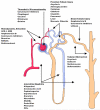Biomarkers of nephrotoxic acute kidney injury
- PMID: 18294749
- PMCID: PMC4038970
- DOI: 10.1016/j.tox.2007.12.024
Biomarkers of nephrotoxic acute kidney injury
Abstract
Acute kidney injury (AKI) is a common condition with significant associated morbidity and mortality. Epidemiologic data suggest that a significant proportion of AKI cases is at least partially attributable to nephrotoxin exposure. This is not surprising given intrinsic renal susceptibility to toxicant-induced injury, a consequence of the unique physiologic and biochemical properties of the normally functioning kidney. A number of pathophysiologic mechanisms have been identified that mediate toxic effects on the kidney, resulting in a variety of clinical syndromes ranging from subtle changes in tubular function to fulminant renal failure. Unfortunately, standard metrics used to diagnose and monitor kidney injury, such as blood urea nitrogen and serum creatinine, are insensitive and nonspecific, resulting in delayed diagnosis and intervention. Considerable effort has been made to identify biomarkers that will allow the earlier diagnosis of AKI. Further characterization of these candidate biomarkers will clarify their utility in the setting of acute nephrotoxicity, define new diagnostic and prognostic paradigms for kidney injury, facilitate clinical trials, and lead to novel effective therapies.
Figures
References
-
- Alchi B, Nishi S, Kondo D, Kaneko Y, Matsuki A, Imai N, Ueno M, Iguchi S, Sakatsume M, Narita I, Yamamoto T, Gejyo F. Osteopontin expression in acute renal allograft rejection. Kidney international. 2005;67:886–896. - PubMed
-
- Ascione R, Lloyd CT, Underwood MJ, Gomes WJ, Angelini GD. On-pump versus off-pump coronary revascularization: evaluation of renal function. The Annals of thoracic surgery. 1999;68:493–498. - PubMed
-
- Bailly V, Zhang Z, Meier W, Cate R, Sanicola M, Bonventre JV. Shedding of kidney injury molecule-1, a putative adhesion protein involved in renal regeneration. J Biol Chem. 2002;277:39739–39748. - PubMed
-
- Basile DP, Fredrich K, Alausa M, Vio CP, Liang M, Rieder MR, Greene AS, Cowley AW., Jr. Identification of persistently altered gene expression in the kidney after functional recovery from ischemic acute renal failure. Am J Physiol Renal Physiol. 2005;288:F953–963. - PubMed
-
- Bazzi C, Petrini C, Rizza V, Arrigo G, Napodano P, Paparella M, D’Amico G. Urinary N-acetyl-beta-glucosaminidase excretion is a marker of tubular cell dysfunction and a predictor of outcome in primary glomerulonephritis. Nephrol Dial Transplant. 2002;17:1890–1896. - PubMed
Publication types
MeSH terms
Substances
Grants and funding
LinkOut - more resources
Full Text Sources
Other Literature Sources
Medical
Miscellaneous


